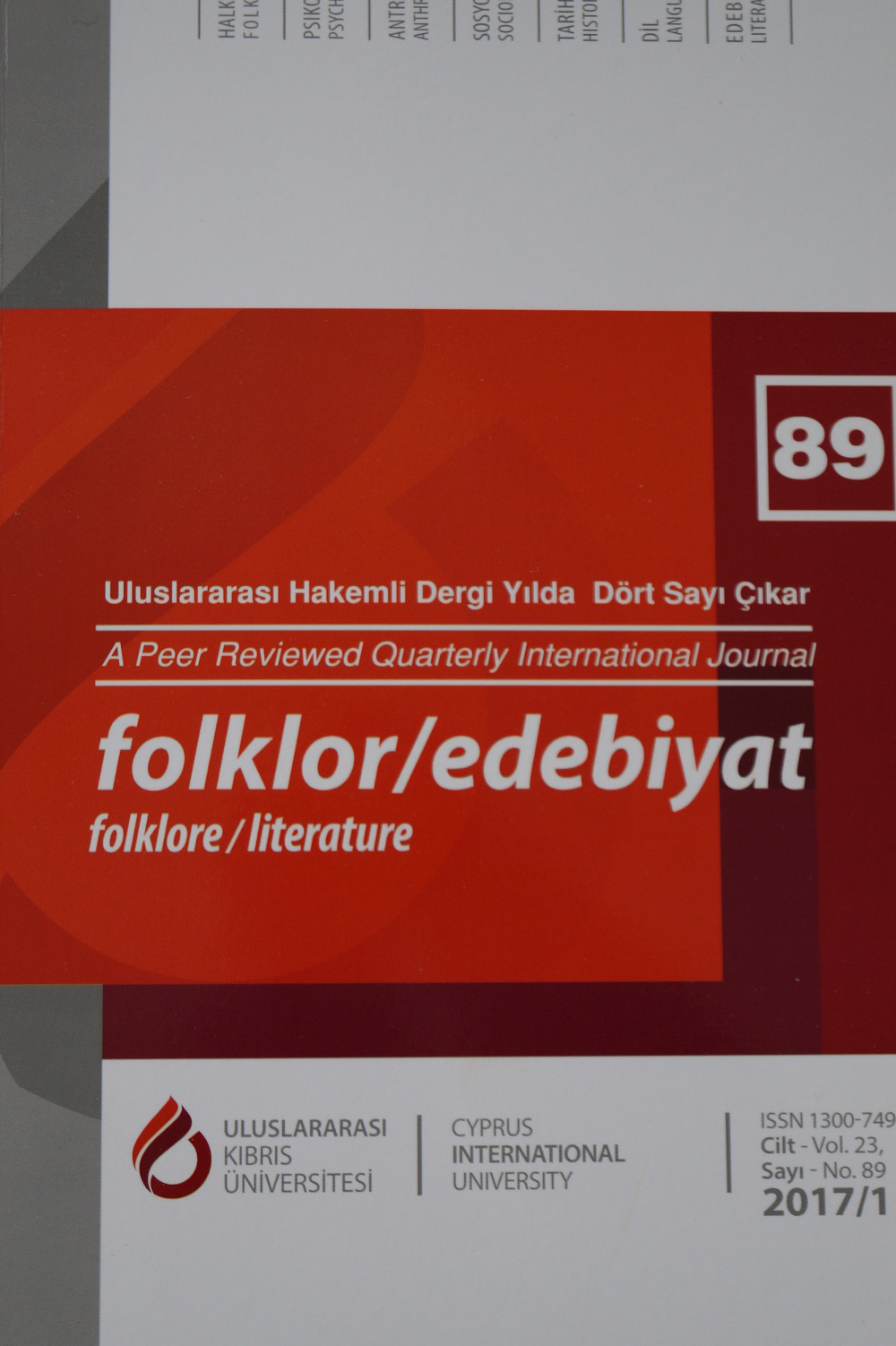
JOURNAL OF FOLKLORE/LITERATURE
Cyprus International University
DOI: 10.5897/UJ-FOLKLORE
Email: folkloredebiyat@ciu.edu.tr
WEST ANATOLI POLICE (THE CITY STATES OF) GEOPOLITICS AND FORMATION
DOI: 10.5897/UJ-FOLKLORE.17.002.1 | Article Number: 0829ADDB2 | Vol.89 (1) - January 2017
Author: Gözlü Ahmet
Keywords: Police, Oikos, Geopolitics, Mycenaean, Topography
The Aegean Basin, BC Since I millenium, police (city-states) in the historical process that can be called the first stage of political power ‘basileus’ called was in the hands of the king. The police, in the ancient world, western culture-specific geo-political and a social unit, BC 8. together with the century has been the model of a new political authority and society. This model was different from the system of the East. The autocratic system of the Eastern world; abstracted from public and political life of a paid army subordinate of the king of the gods and a central apparatus officers, constituted the backbone of socio-political structure. The police is beyond the exclusive properties of the implementation of direct democracy, free (Eleuthera), independent (autonomie) and self-sufficient (autherki) unit were.
Western Anatolia and Greece (Hellas) in the landscape, resulting in a fragmented topog- raphy of the core structure of the police, which called on behalf of Oikos ‘Family Business’ was created. Relative to the police (city-states) was the product of this core structure come together in appropriate circumstances and expansion. Narrower than in Western Anatolia in Ionia with a geographical name, the police have completed basic restructuring processes, BC In the 6th century they began to experience the most advanced and mature period and a specific ‘spatial patterns of socio-political’ evolved into. This mold, Mesopotamia, all intellectual and cultural heritage of Anatolia and Egypt was formulated in a new philosophical and scien- tific level, as already established historical foundations of the modern Western mind, marital value of mainly old age, the Western Anatolia and the Aegean was moved by police .In this study, the constant as an argument to the geopolitics of the police and the police, highlighting the special geography where Western Anatolia in a natural and bears a date of their intention to shed light on the development.
Akurgal, Ekrem (2000a). Anadolu Uygarlıkları, İstanbul: Net Turistik Yayınları.
Akurgal, Ekrem (2000b). Ege Batı Uygarlığının Doğduğu Yer, İzmir: İzmir Büyükşehir Be- lediyesi Kültür Yayını.
Aktüre, Sevgi (2003). Anadolu’da Demir Çağ Kentleri, İstanbul: Tarih Vakfı Yayınları. Alioğlu, Alparslan ve Abdullah Uğur (2012). Şehir Coğrafyası, Ankara: Nobel Akademik
Yayıncılık.
Blunt, A. W. F (1984). Batı Uygarlığının Temelleri, Çev. Müzehher Erim, İstanbul: İstanbul Üniversitesi Edebiyat Fakültesi Yayınları.
Cadoux, John Cecil (2003). İlk Çağda İzmir, Çev. Bilge Umar, İstanbul: İletişim Yayınları.
Cook, J. M. (1982). “East Greece”, The Cambridge Ancient History, Vol III, Part I, Camb- ridge: Cambridge University Press, ss.745-753.
Freeman, Charles 82003). Mısır, Yunan ve Roma, Çev. Suat Kemal Angı, Ankara: Dost Ki- tabevi Yayınları.
Ferguson, W. K. ve Geoffrey Bruun (1964). “Ancient Greece”, A Survey of European Civi- lization, Boston: Houghton Mifflin Company, ss. 24-29.
Gates, Charles (2003). Ancient Cities, London: Routledge Taylor and Francis Group. Herodotos (1991). Herodot Tarihi, İstanbul: Remzi Kitabevi.
İplikçioğlu, Bülent (1994). Eski Tarihinin Anahatları II, İstanbul: Bilim Teknik Yayınları. Jeffery, L.H (1976). Archaic Greece The City-States C.700-500 B.C., London: Methuen Co LTD.
Mansel, Arih Müfid (1999). Ege ve Yunan Tarihi, Ankara: TTK Yayınları.
Mumford, Lewis (2007). Tarih Boyunca Kent, Çev. Gürol Koca ve Tamer Tosun, İstanbul: Ayrıntı Yayınları.
Morris, Ian (2000). “Kent ve Devlet Olarak Erken Polis”, Antik Dünyada Kırsal ve Kent, Çev. Lale Özgenel, İstanbul: Homer Yayıncılık, ss. 25-58.
Rihl, T. E. Ve A. G. Wilson (2000). “Antik Yunanistan’da Yerleşim Yapılarının Modellen- mesi: Polis’e Yeni Yaklaşımlar”, Antik Dünyada Kırsal ve Kent, Çev. Lale Özgenel, İstanbul: Homer Yayıncılık, ss. 59-95.
Reader , John (2007). Şehirler, Çev. Fatine Bahar Karlıdağ, İstanbul: Yapı Kredi Yayınları.
Snodgrass, A.M (2000). “Arkeoloji ve Yunan Kentinin Çalışılması”, Antik Dünyada Kırsal ve Kent, Çev. Lale Özgenel, İstanbul: Homer Yayıncılık, ss. 1-22.
Starr, C.G (1982). “Economic and Social Conditions in the Greek World”, The Cambridge Ancient History, Vol III, Part III, Cambridge: Cambridge University Press, ss. 417-441.
Tekin, Oğuz (1995). Eski Yunan Tarihi, İstanbul: İletişim Yayınları.
Tümertekin, Erol ve Nazmiye Özgüç (2011). Beşeri Coğrafya, İstanbul: Çantay Kitabevi. Thomson, George (1991). Tarihöncesi Ege II, Çev. Celal Üster, İstanbul: Payel Yayınları. Trevor, Ling (1973). “The Prophet of the East”, Ancient Empires, George Weidenfeld and Nicolson Ltd, ss. 69-75.
Umar, Bilge (1999). İlk Çağda Türkiye Halkı, İstanbul: İnkılap Kitabevi Yayınları.
Wallace-Hadrill, Andrew (2000). Antik Dünyada Kırsal ve Kent, Çev. Lale Özgenel, İstan- bul: Homer Yayıncılık, ss. IX-XIX.
Yalçınlar, İsmail (1996). Strüktürel Jeomorfoloji, Cilt: I, Konya: Öz EğitimYayınları.
